Abstract
Aged asphalt mixture is heavily involved in pavement maintenance and renewed construction because of the development of recycling techniques. The aged bitumen binder has partially lost its viscous behavior. Rejuvenators are therefore designed and used in this recycling procedure to enhance the behavior of such aged reclaimed bitumen. However, tests have not yet been clearly specified to understand the diffusion characteristics of rejuvenators in aged bitumen. In this research, molecular dynamic simulation is proposed and conducted with Materials Studio software to study the diffusion behavior of rejuvenators in aged bitumen at the molecular level. Two rejuvenators, named R-1 and R-2, were included. The difference between these two rejuvenators is their chemical composition of C=O. The diffusion coefficient is determined by studying the molecular movement. Results illustrate that the proposed models can be used to study the diffusion of rejuvenators in aged bitumen sufficiently. In the meantime, a dynamic shear rheometer (DSR) is used to evaluate the recovery influence on aged bitumen resulting from rejuvenators. The experimental results strengthen the model simulations and indicate that the aging index of bitumen has a significant influence on the rejuvenating effect. Research results indicate that rejuvenators have a sufficient rejuvenating effect on the long-term aged bitumen and a limited effect on short-term aged bitumen.
1. Introduction
Reclaimed asphalt [1], which is of great importance for conserving resources and protecting the environment, is one of the largest fractions of recycled raw materials used in road construction [2,3,4]. Rejuvenators are employed in many cases to improve the flexibility, which means better stress relaxation and softer properties of such aged reclaimed asphalt. The performance of these reclaimed asphalts depends on the mixing degree of rejuvenators and aged bitumen [5]. Two of the main factors that assist in the mixing efficiency are the blending condition and the diffusion process [6,7]. This study therefore focused on the diffusion process of rejuvenators in aged bitumen during hot recycling.
Molecular diffusion plays an important role in bitumen recovery process as well as in numerous engineering applications [8]. Mazzotta used FTIR (Fourier transform infrared spectroscopy) to carry out chemical analysis of molecular changes during the bitumen aging process [9]. Indexes of IC=O and IS=O were defined and successfully used to characterize the changes of functional groups. Many studies on diffusion in bituminous materials have been successfully carried out recently. A method based on FTIR-ATR (Fourier Transform Infrared Spectroscopy using Attenuated Total Reflectance) was developed and described by Karlsson and Isacsson [10,11]. Using this method, diffusion rates are influenced by the temperature, size, and shape of the diffusion molecules. A positive outcome of that study was that aging showed very little influence on diffusion [12]. Karlsson and Isacsson [13] also did some laboratory studies on diffusion in bitumen using markers. They selected diphenyl-silane and t-butyldiphenylsilyl (DPS) as markers. They monitored the diffusion through the binder, and the importance of diffusant size and polarity on diffusion rate was demonstrated. Research on the diffusion of rejuvenators in aged bitumen has been further investigated using molecular dynamic simulation to calculate the diffusion coefficient.
Molecular simulation technology can be used to calculate the molecular conformations and diffusion process between different materials [14]. The establishment of the model mainly relies on system parameters such as the sizes of scale, the degree of light and shade, the colors, and the different structures of the microscopic particles themselves. The molecular simulation technique is an experimental technology based on computer analysis. This technology can simulate the static characteristics and motor behavior of molecules by setting up a reasonable molecular model to define the chemical and physical properties of the micro system [15]. Dong and Wang successfully used molecular dynamic simulation method to study the asphalt–aggregate interface [16,17]. Wang also used molecular dynamics simulation to characterize the oxidative aging effect in asphalt binder. Mean square displacement and diffusion coefficient were analyzed, and aged binder was found to have a higher activation energy barrier that decreased its viscoelastic behavior [18,19]. Huang applied molecular dynamic simulation to investigate the diffusion between virgin binder and aged binder, which was then verified with gel permeation chromatography [20,21]. They reported that the diffusion ability is a function of the diffusion ability itself and the diffusion environment. All of this research leads to a powerful method of studying the diffusion of rejuvenators in aged bitumen binder.
In this research, the chemical bond morphology of the investigated rejuvenators was first characterized to define structures for molecular dynamic simulation. Then, the molecular dynamic method was used, and the COMPASS force field was adopted to discuss the diffusion properties of the modeled rejuvenators in aged bitumen. Einstein’s model was employed to analyze the results obtained from a computer and to calculate the diffusion coefficient [22]. At the same time, rheological properties of rejuvenated bitumen treated by different rejuvenators were characterized. These laboratory tests were conducted to further understand the findings from the molecular simulation on the diffusion and rejuvenating effect.
2. Materials and Methods
2.1. Materials
The 80/100 penetration grade bitumen provided by the Panjin asphalt company (Sichuan, China) was used in this research. The short-term aged bitumen used in this research was aged using the standard rolling thin-film oven test (RTFOT) at a temperature of 163 °C for 85 min. Long-term aged bitumen was obtained by means of a pressure aging vessel (PAV) and an ultraviolet aging oven (UV). The PAV was conducted at 95 °C with pressure of 2.1 MPa for 20 h. The ultraviolet aging oven was set with an ultraviolet intensity of 79.5 W/m2 and aged for 168 h. Both short-term aged and long-term aged binders were then treated with rejuvenators. The rejuvenating contribution to short-term aged binder was studied to understand the recovering ability during hot mixing.
The rejuvenator-treated aged bitumen was prepared in two steps. Firstly, the aged bitumen was blended with 8% of R-1 or R-2, separately, using the propeller mixer (GS-1, Tianjin, China) for 30 min at 120 °C with a constant speed of 200 rpm. Secondly, the rejuvenator-treated bitumen was then allowed to sit at room temperature for 3 days before being used for further rheological analysis to ensure completed diffusion.
The rejuvenators, named R-1 and R-2, used throughout this research were provided by CRAFCO Company (Wuxi, P.R. China). Table 1 displays the basic technical data of R-1 and R-2. They are liquid and made from emulsified bitumen, containing about 61.8% to 76.5% of residue after fully cured.

Table 1.
Technical data of Rejuvenators R-1 and R-2.
2.2. Molecular Dynamic Simulation
Molecular dynamic simulation was performed using Materials Studio software (Materials Studio 8.0, BIOVIA, Beijing, China). The compass force field was used only for describing atomic level interactions in molecular models. According to the literature, the saturates, aromatics, and asphaltenes in aged bitumen were modeled as a straight chain alkane C22H46, 1,7-dimethyl-naphthalene [23,24], and Groenzin’s and Mullin’s model C72H98S [25], respectively.
Components of rejuvenators were first determined, and R-1 and R-2 were then defined as simplified monomer that consists of functional groups as Table 2 indicates. For simplified calculations, C13H15NO3 and C11H13NO2 were defined for R-1 and R-2, respectively.

Table 2.
Functional groups in the rejuvenators used.
The simulation process of diffusion coefficients mainly includes two parts: energy minimization and a dynamic simulation process. After energy optimization, a canonical ensemble (NVT) and an isobaric–isothermal ensemble (NPT) were simultaneously applied for the first 50 picoseconds (ps) to ensure a density stable system [26]. NVT is a statistical ensemble that represents the possible states of a mechanical system in thermal equilibrium with a heat bath at a fixed temperature [27]. The system can exchange energy with the heat bath, so the states of diffusion system will differ in total energy. NPT is a statistical mechanical ensemble that maintains a constant temperature and a constant applied pressure [28].
The molecular dynamic simulation was running at a simulated temperature of 25 °C. Then, NVT dynamic simulation was used in the following 50 ps. The movement locus of the molecule was recorded to study the diffusion coefficient. Figure 1 presents the diffusion models. R-1 and R-2 are located in the boundary of the RTFOT aged asphalt at the initial stage, and are diffused into the center at a stable stage after full diffusion.
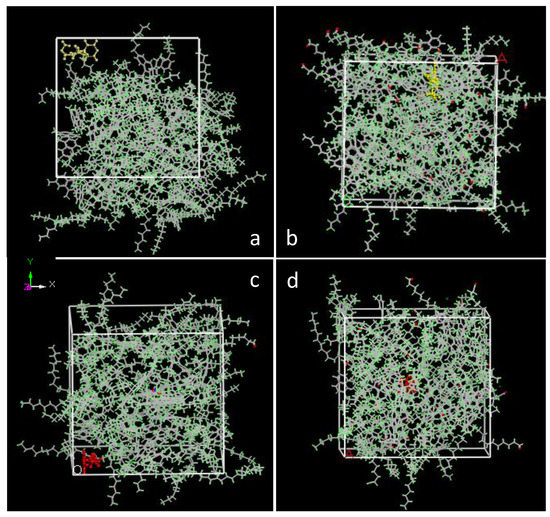
Figure 1.
Diffusion models: the initial stage (a) and the stable stage (b) of R-1 in the rolling thin-film oven test (RTFOT) aged asphalt models; the initial stage (c) and the stable stage (d) of R-2 in the RTFOT aged asphalt models.
2.3. Rheological Properties Test
The dynamic shear rheometer (DSR) (Anton Paar, Graz, Austria) is usually used to characterize both viscous and elastic behaviors of bitumen by measuring the complex shear modulus and phase angle. A temperature sweep test was conducted. A sinusoidal signal of stress was applied. The complex shear modulus represents the sample’s total resistance to the applied deformation during sinusoidal stress conditions. Phase angle is described as the lag between applied shear stress and the resulting shear strain. The higher the complex shear modulus value, the stiffer the bitumen binder is. The larger the measured phase angle, the more viscous the binder is [29]. The temperature sweep test was performed at a fixed frequency of 10 rad/s and in temperature ranges from −10 to 60 °C with temperature increments of 2 °C per minute.
In this research, DSR tests were conducted on virgin bitumen, aged bitumen (RTFOT, PAV, UV), and rejuvenated bitumen with 8% R-1 or 8% R-2. According to the test specification [30], different geometries of specimens are specified for different temperature conditions. The diameter of the plate that contains the bitumen binder is 8 mm, and the thickness is 2 mm when the temperature is lower than 20 °C. When the temperature is higher than 20 °C, the plate diameter should be 25 mm, and the thickness of bitumen binder should be 1 mm. Strain sweep tests with increasing applied strain were first conducted to study the viscoelastic range of virgin, aged, and rejuvenated bitumen binder. Based on strain sweep tests, strains were selected based on viscoelastic ranges of every type of binder for temperature sweep analysis, ensuring that all of the performed DSR moduli and phase angle evaluations are conducted in the viscoelastic range of the tested bitumen binder. Table 3 summarizes the applied strains.

Table 3.
Applied shear stains during dynamic shear rheometer (DSR) analysis.
3. Results and Discussion
3.1. Molecular Calculation Results
3.1.1. Mean Squared Displacement
The diffusion coefficients and diffusion mechanisms in R-1- and R-2-treated RTFOT, PAV, and UV aged asphalt were modeled and studied. The molecular dynamic simulation of the diffusion process can be investigated by recording the movement locus of the molecular particles. The mean squared displacement (MSD) of the analyzed particles can therefore be finalized by means of this movement.
Figure 2 compares MSD values along with diffusion time for rejuvenators in aged bitumen binder. In both R-1-modified and R-2-modified bitumen binder, the MSD values decrease in order of UV aged, PAV aged, and RTFOT aged binder. Rejuvenator R-1 performs higher MSD values than R-2 in bitumen binder with the same aging index, which means R-1 diffuses faster than R-2 in aged bitumen.
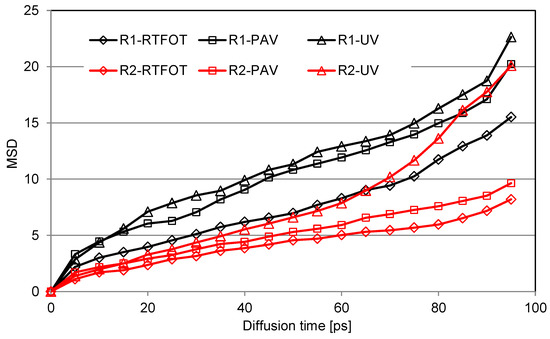
Figure 2.
Mean squared displacement (MSD) curves of rejuvenators in aged bitumen at 150 °C.
3.1.2. Diffusion Coefficient
MSD values are then used to calculate the diffusion coefficient (D) via Einstein’s formula as follows:
where ri(t) is the displacement of particle i at time t, and ri(0) is the displacement at the starting time. In this formula, N represents the diffused particles of the system. When the MSD curve presents a linear trend, the equation can be simplified as follows:
where T is the total time of atoms or molecule movements. D is the 1/6 slope of the simplified linear curve.
In the R-1-treated bitumen, the calculated D of the rejuvenator in RTFOT, PAV, and UV aged bitumen is 2.26 × 10−10, 2.82 × 10−10, and 3.09 × 10−10, respectively. The calculated D of Rejuvenator R-2 in RTFOT, PAV, and UV aged bitumen is 1.18 × 10−10, 1.35 × 10−10, and 3.05 × 10−10. Firstly, this illustrates that the severity level of aging has a significant influence on the diffusion of rejuvenators. Investigated rejuvenators diffuse easier and faster in the long-term aged binder, such as the UV aged binder, but diffuse slower in the short-term aged bitumen binder. Secondly, R-1 presents a higher diffusion coefficient in aged bitumen than does R-2, which indicates that R-1 has a better diffusion coefficient in the aged bitumen.
3.2. The Effect of Rejuvenators on the Rheological Properties
Figure 3 presents the complex shear modulus and phase angle of virgin bitumen, RTFOT aged bitumen, and rejuvenated bitumen with 8% R-1 or 8% R-2 in the higher temperature range. It is shown that the complex shear modulus of RTFOT aged bitumen is much higher, and the phase angle is much lower than that of the virgin bitumen. This indicates that aged bitumen is more elastic and stiffer. The introduction of 8% R-1 or 8% R-2 into aged bitumen decreases the complex shear modulus and obviously increases the phase angle. This means that the addition of R-1 or R-2 can reduce the aging degree of bitumen. Furthermore, the complex shear modulus of RTFOT aged bitumen treated with 8% R-1 is lower than that of the aged bitumen treated with 8% R-2, while the phase angle of R-1-treated bitumen is higher and the curve is closer to the virgin bitumen, compared to that of R-2-treated specimens. These results indicate that, although both R-1 and R-2 can recover the rheological properties of RTFOT aged bitumen, R-1 obviously has a stronger recovery capability of rheological properties than does R-2.
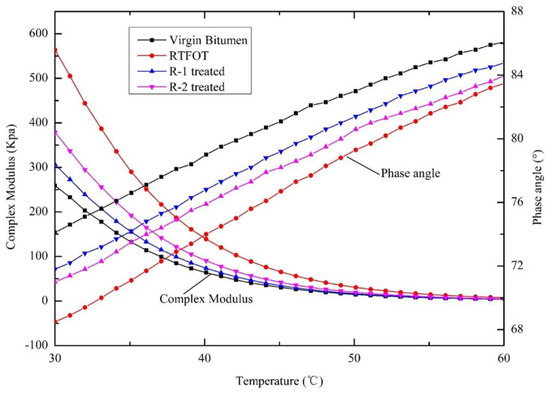
Figure 3.
Effect of rejuvenators on RTFOT aged bitumen at higher temperatures.
Figure 4 and Figure 5 reveal the complex shear modulus and phase angle of PAV aged bitumen and UV aged bitumen in the higher temperature range, respectively. The rejuvenating effect of the investigated rejuvenators on PAV aged bitumen is similar to the effect on RTFOT aged bitumen. While for the UV aged bitumen, the impact of R-2 is limited. Figure 5 shows that the phase angle curves of UV aged bitumen and R-2-treated bitumen overlap. The previous molecular calculation shows a higher diffusion coefficient of R-1 in aged binder than that of R-2. Figure 3, Figure 4 and Figure 5 provide strong evidence that R-1 exhibits a much greater rejuvenating influence on the viscoelastic behavior at higher temperature conditions than does R-2.
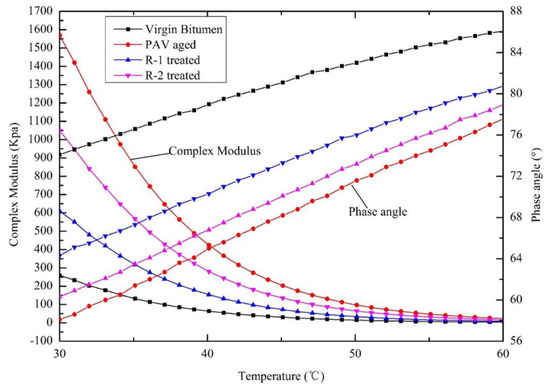
Figure 4.
Effect of rejuvenators on pressure aging vessel (PAV) aged bitumen at higher temperatures.
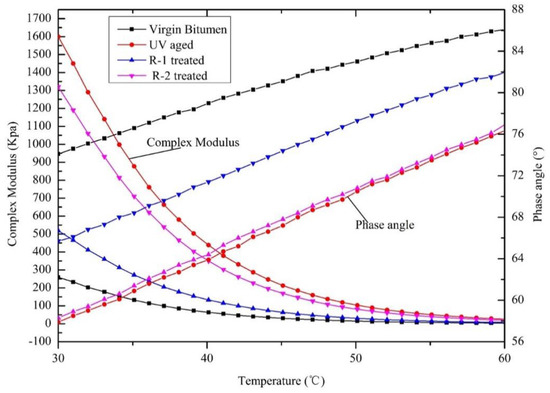
Figure 5.
Effect of rejuvenators on UV aged bitumen at higher temperatures.
Figure 6, Figure 7 and Figure 8 present the complex shear modulus and phase angle at lower temperatures of virgin bitumen, RTFOT (or PAV, or UV) aged bitumen, and rejuvenator-treated bitumen. The complex shear modulus of aged bitumen is higher than that of virgin bitumen. We all know that aged bitumen is very brittle and easily cracks under loading at low temperature. The addition of R-1 and R-2 can also decrease the complex shear modulus and increase the phase angle at lower temperatures. This does mean, however, that both R-1 and R-2 can significantly improve low-temperature properties of RTFOT aged bitumen and extend the service life of bitumen in a lower temperature condition. The modulus curve of aged bitumen treated with R-1 is closer to the curve of virgin bitumen, while the curve of aged bitumen treated with R-2 is closer to the curve of aged bitumen. This phenomenon indicates once again that R-1 has a stronger recovery capability of lower temperature behavior of aged bitumen than does R-2.
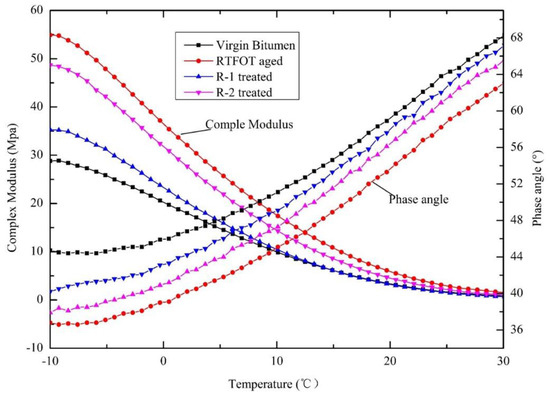
Figure 6.
Effect of rejuvenators on RTFOT aged bitumen at lower temperatures.
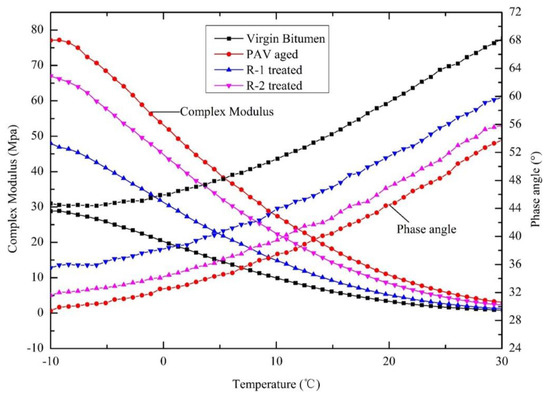
Figure 7.
Effect of rejuvenators on PAV aged bitumen at lower temperatures.

Figure 8.
Effect of rejuvenators on UV aged bitumen at lower temperatures.
Furthermore, Figure 3, Figure 4, Figure 5, Figure 6, Figure 7 and Figure 8 illustrate that the curve of aged bitumen treated with R-1 in the lower temperature range is closer to the curve of virgin bitumen than that in the higher temperature range. This indicates that the recovery capacity of R-1 on the lower temperature behavior is more significant than that on the higher temperature behavior. Figure 3, Figure 4, Figure 5, Figure 6, Figure 7 and Figure 8 also show that the distinction between regenerative capacity of R-1 and R-2 is more obvious on the lower temperature properties than that on the higher temperature properties.
Practically speaking, RTFOT, which represents short-term aging, results in a minor property deterioration of bituminous materials. Therefore, in the long-term aged bitumen, such as UV aged binder, the rejuvenating effect resulting from R-1 and R-2 presents a significant difference from that in the case of short-term aged binder. In Figure 3 and Figure 6, both R-1 and R-2 present an obvious rejuvenating contribution. Nevertheless, in Figure 5 and Figure 8, R-1 shows a nice rejuvenating effect, while R-2 has a very limited influence on the properties of modulus and phase angle. This illustrates that the key to designing a good rejuvenator is the improvement of its effect on long-term aged binder, instead of focusing on short-term aged binder. An improved rejuvenator should have a sufficient effect on rejuvenating long-term aged bitumen.
4. Conclusions
Molecular dynamic simulation was established in this research to simulate the actual movement of rejuvenators in aged bitumen and to characterize their diffusion coefficient. Then, DSR tests were carried out to further investigate the rejuvenating effect. Based on the discussed results, the following can be concluded:
- Molecular dynamic simulation and rheological analysis results indicate that the severity level of aging has a significant influence on the diffusion coefficient and rejuvenating effect of rejuvenators. The investigated rejuvenators diffuse faster and more easily in the long-term aged binder, such as UV aged binder, but diffuse slower in the short-term aged bitumen binder. Consequently, there is a sufficient rejuvenating effect on the long-term aged bitumen and a limited effect on the short-term aged bitumen.
- Both R-1 and R-2 can reduce the complex modulus and increase the phase angle of the long-term aged bitumen, but R-1 has a greater recovery capacity than R-2. The rejuvenators presented greater rejuvenate ability at lower temperatures than at higher temperatures.
- Molecular simulation indicates that R-1 has a higher diffusion coefficient in aged bitumen binder than does R-2, while DSR proves that R-1 has greater recovery capacity. Molecular simulation and experiment results from the DSR test match quite well. This means that the molecular simulation proposed in this research can be successfully used to characterize the diffusion coefficient of rejuvenators in aged bitumen.
Acknowledgments
This study was supported by the National Natural Science Foundation of China (No. 51408447) and the National Key Scientific Apparatus Development Program from the Ministry of Science and Technology of China (No. 2013YQ160501).
Author Contributions
Yue Xiao, Chao Li and Yefei Wang conceived and designed the experiments; Chao Li, Miao Wan, and Yefei Wang performed the experiments; Yue Xiao, Chao Li, Miao Wan, and Yefei Wang analyzed the data; Xinxing Zhou and Shaopeng Wu contributed analysis tools; Yue Xiao and Chao Li wrote the paper.
Conflicts of Interest
The authors declare no conflict of interest.
References
- Wu, S.; Qiu, J.; Mo, L.; Yu, J.; Zhang, Y.; Li, B. Investigation of temperature characteristics of recycled hot mix asphalt mixtures. Resour. Conserv. Recycl. 2007, 51, 610–620. [Google Scholar] [CrossRef]
- Cui, P.; Wu, S.; Xiao, Y.; Wan, M.; Cui, P. Inhibiting effect of layered double hydroxides on the emissions of volatile organic compounds from bituminous materials. J. Clean. Prod. 2015, 108, 987–991. [Google Scholar] [CrossRef]
- Li, X.-G.; Lv, Y.; Ma, B.-G.; Chen, Q.-B.; Yin, X.-B.; Jian, S.-W. Utilization of municipal solid waste incineration bottom ash in blended cement. J. Clean. Prod. 2012, 32, 96–100. [Google Scholar] [CrossRef]
- Chen, Z.; Wu, S.; Xiao, Y.; Zeng, W.; Yi, M.; Wan, J. Effect of hydration and silicone resin on basic oxygen furnace slag and its asphalt mixture. J. Clean. Prod. 2016, 112, 392–400. [Google Scholar] [CrossRef]
- Chen, M.; Xiao, F.; Putman, B.; Leng, B.; Wu, S. High temperature properties of rejuvenating recovered binder with rejuvenator, waste cooking and cotton seed oils. Constr. Build. Mater. 2014, 59, 10–16. [Google Scholar] [CrossRef]
- Ma, T.; Wang, H.; Zhao, Y.; Huang, X.; Pi, Y. Strength mechanism and influence factors for cold recycled asphalt mixture. Adv. Mater. Sci. Eng. 2015, 2015, 181853. [Google Scholar] [CrossRef]
- Ma, T.; Huang, X.; Zhao, Y.; Zhang, Y. Evaluation of the diffusion and distribution of the rejuvenator for hot asphalt recycling. Constr. Build. Mater. 2015, 98, 530–536. [Google Scholar] [CrossRef]
- Sheikha, H.; Mehrotra, A.K.; Pooladi-Darvish, M. An inverse solution methodology for estimating the diffusion coefficient of gases in athabasca bitumen from pressure-decay data. J. Pet. Sci. Eng. 2006, 53, 189–202. [Google Scholar] [CrossRef]
- Dondi, G.; Mazzotta, F.; Simone, A.; Vignali, V.; Sangiorgi, C.; Lantieri, C. Evaluation of different short term aging procedures with neat, warm and modified binders. Constr. Build. Mater. 2016, 106, 282–289. [Google Scholar] [CrossRef]
- Karlsson, R.; Isacsson, U.; Ekblad, J. Rheological characterisation of bitumen diffusion. J. Mater. Sci. 2007, 42, 101–108. [Google Scholar] [CrossRef]
- Karlsson, R.; Isacsson, U. Application of ftir-atr to characterization of bitumen rejuvenator diffusion. J. Mater. Civ. Eng. 2003, 15, 157–165. [Google Scholar] [CrossRef]
- Karlsson, R.; Isacsson, U. Investigations on bitumen rejuvenator diffusion and structural stability (with discussion). J. Assoc. Asph. Paving Technol. 2003, 72, 463–501. [Google Scholar]
- Karlsson, R.; Isacsson, U. Laboratory studies of diffusion in bitumen using markers. J. Mater. Sci. 2003, 38, 2835–2844. [Google Scholar] [CrossRef]
- Mueller-Plathe, F.; Rogers, S.C.; Van Gunsteren, W.F. Diffusion coefficients of penetrant gases in polyisobutylene can be calculated correctly by molecular-dynamics simulations. Macromolecules 1992, 25, 6722–6724. [Google Scholar] [CrossRef]
- Hofmann, D.; Fritz, L.; Ulbrich, J.; Paul, D. Molecular simulation of small molecule diffusion and solution in dense amorphous polysiloxanes and polyimides. Comput. Theor. Polym. Sci. 2000, 10, 419–436. [Google Scholar] [CrossRef]
- Dong, Z.; Liu, Z.; Wang, P.; Gong, X. Nanostructure characterization of asphalt-aggregate interface through molecular dynamics simulation and atomic force microscopy. Fuel 2017, 189, 155–163. [Google Scholar] [CrossRef]
- Xu, G.; Wang, H. Molecular dynamics study of interfacial mechanical behavior between asphalt binder and mineral aggregate. Constr. Build. Mater. 2016, 121, 246–254. [Google Scholar] [CrossRef]
- Xu, G.; Wang, H. Molecular dynamics study of oxidative aging effect on asphalt binder properties. Fuel 2017, 188, 1–10. [Google Scholar] [CrossRef]
- Pan, P.; Wu, S.; Xiao, Y.; Liu, G. A review on hydronic asphalt pavement for energy harvesting and snow melting. Renew. Sustain. Energy Rev. 2015, 48, 624–634. [Google Scholar] [CrossRef]
- Ding, Y.; Huang, B.; Shu, X.; Zhang, Y.; Woods, M.E. Use of molecular dynamics to investigate diffusion between virgin and aged asphalt binders. Fuel 2016, 174, 267–273. [Google Scholar] [CrossRef]
- Pan, P.; Wu, S.; Hu, X.; Liu, G.; Li, B. Effect of material composition and environmental condition on thermal characteristics of conductive asphalt concrete. Materials 2017, 10, 218. [Google Scholar] [CrossRef]
- Sonnenburg, J.; Gao, J.; Weiner, J. Molecular dynamics simulations of gas diffusion through polymer networks. Macromolecules 1990, 23, 4653–4657. [Google Scholar] [CrossRef]
- Zhang, L.; Greenfield, M.L. Analyzing properties of model asphalts using molecular simulation. Energy Fuels 2007, 21, 1712–1716. [Google Scholar] [CrossRef]
- Bhasin, A.; Bommavaram, R.; Greenfield, M.L.; Little, D.N. Use of molecular dynamics to investigate self-healing mechanisms in asphalt binders. J. Mater. Civ. Eng. 2010, 23, 485–492. [Google Scholar] [CrossRef]
- Groenzin, H.; Mullins, O.C. Molecular size and structure of asphaltenes from various sources. Energy Fuels 2000, 14, 677–684. [Google Scholar] [CrossRef]
- Zhou, X.; Wu, S.; Liu, G.; Pan, P. Molecular simulations and experimental evaluation on the curing of epoxy bitumen. Mater. Struct. 2016, 49, 241–247. [Google Scholar] [CrossRef]
- Sadus, R.J. Molecular Simulation of Fluids; Elsevier Science Ltd.: New York, NY, USA, 2002. [Google Scholar]
- Bosko, J.T.; Todd, B.; Sadus, R.J. Molecular simulation of dendrimers and their mixtures under shear: Comparison of isothermal-isobaric (NPT) and isothermal-isochoric (NVT) ensemble systems. J. Chem. Phys. 2005, 123, 034905. [Google Scholar] [CrossRef] [PubMed]
- Xiao, Y.; van de Ven, M.; Molenaar, A.; Su, Z.; Zandvoort, F. Characteristics of two-component epoxy modified bitumen. Mater. Struct. 2011, 44, 611–622. [Google Scholar] [CrossRef]
- CEN-European Committee for Standardization. Nen-en 14770 Bitumen and Bituminous Binders-Determination of Complex Shear Modulus and Phase Angle-Dynamic Shear Rheometer (DSR); BSI: London, UK, 2012. [Google Scholar]
© 2017 by the authors. Licensee MDPI, Basel, Switzerland. This article is an open access article distributed under the terms and conditions of the Creative Commons Attribution (CC BY) license (http://creativecommons.org/licenses/by/4.0/).










